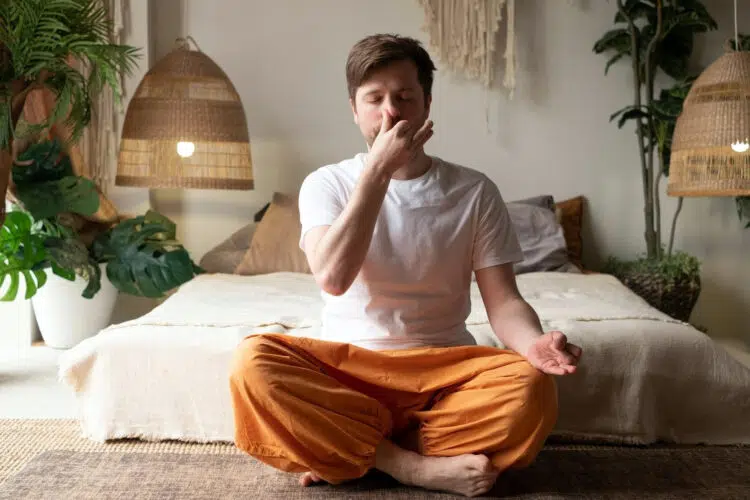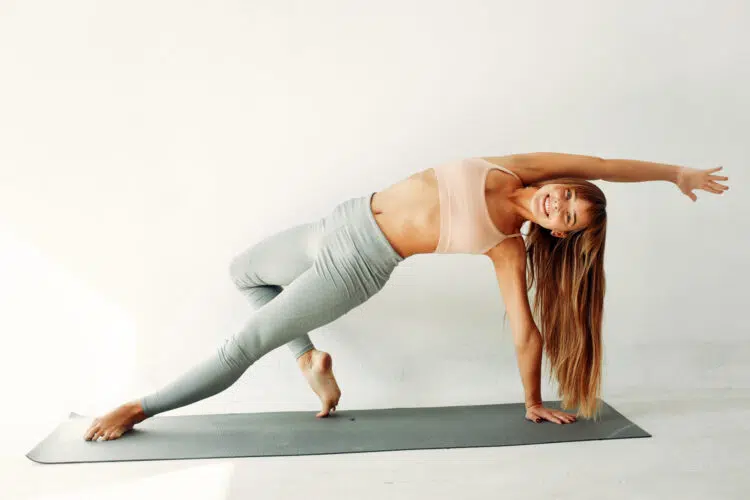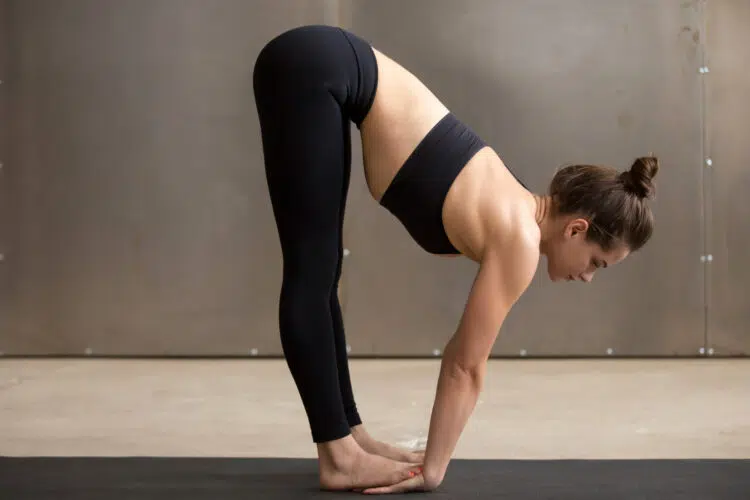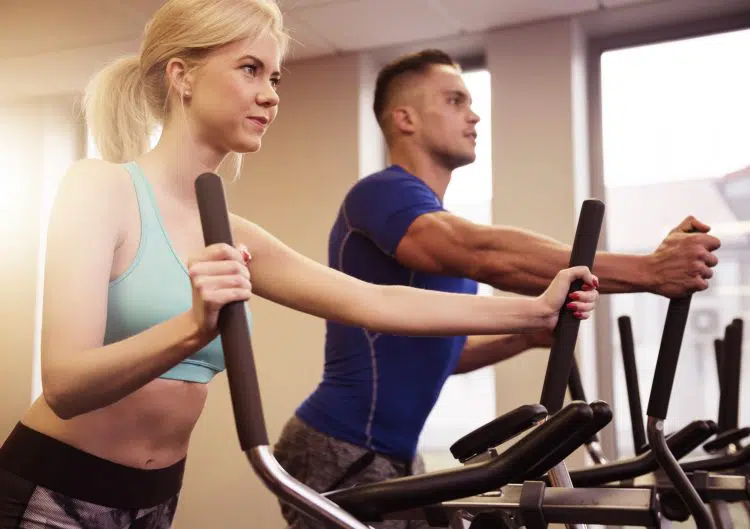In today’s fast-paced world, anxiety is turning into a pandemic. According to the World Health Organisation, an estimated four percent of the global population currently experience an anxiety disorder, making it the most common of all mental disorders. (1)
If that wasn’t bad enough, only about one in four people in need (27.6%) receive any treatment for this issue. (2)
The thing about anxiety is that most people go undiagnosed and only seek help when it turns into even more serious issues like depression. What are the symptoms of anxiety, you ask? A racing heart, sweaty palms, digestive issues, poor sleep, focus loss, and never-ending worrying thoughts.
The good news is that there is a very powerful and convenient cure for anxiety — exercise.
Contrary to what most people believe, body and mind aren’t separate entities. They must work in harmony to ensure optimal health and well-being.
Poor mental or physical state can keep you from achieving your maximum potential.
Level Up Your Fitness: Join our 💪 strong community in Fitness Volt Newsletter. Get daily inspiration, expert-backed workouts, nutrition tips, the latest in strength sports, and the support you need to reach your goals. Subscribe for free!
Studies have shown that cortisol, the infamous stress hormone, is directly proportional to your anxiety levels. (3)
On the other hand, research suggests that exercise, especially outdoors, is effective in improving mental health outcomes in adults, including those with pre-existing mental health problems. (4)
In this article, I’ll reveal the mind-blowing link between fitness and anxiety and how different types of exercise (yoga, low-intensity cardio, and deep breathing) can lower anxiety levels, improve your mood, and boost energy levels. We have a lot to uncover, so sit tight and read on.
Yoga for Anxiety Relief
Yoga is a group of physical, mental, and spiritual practices or disciplines that originated in ancient India. This practice is known for its effectiveness in controlling the mind and the body.
The demands of daily life can make you feel like you’re dashing on a hamster wheel; it is no wonder our minds are shrouded with anxious thoughts.
Practicing yoga can help you slow down everything around you, find mental peace, focus on what’s important, and build mental resilience.
Make no mistake: yoga isn’t about fancy poses, and you don’t have to do anything that pulls you away from the true essence of this discipline. Yoga literally means “to unite.” You are doing yourself and this discipline a disservice by overlooking this principle.
With this out of the way, let’s explore how yoga can banish anxiety.
Yoga & Your Nervous System
High cortisol levels keep you in the fight-or-flight mode for extended periods, which can be detrimental to your mental and physical health.
Practicing yoga shifts the balance to the parasympathetic nervous system, putting you in the “rest-and-digest” mood. If you feel like yoga is too slow and boring, that is by design. Your brain and body aren’t meant to be chasing adrenaline all the time.
Best Yoga Poses For Relieving Anxiety
There are a plethora of yoga poses that you can choose from, but I’ll make things easier for you by giving you my go-to’s:
- Forward Bends: Standing forward bend or the child’s pose can have a calming effect on your mind as it encourages you to turn inward and release the tension in your body. The more relaxed you are, the better stretch you’ll attain.
- Twists: Your gut health has a major role in your mental and physical well-being. Spinal twisting poses, such as seated twists or revolved triangles, can improve your digestion — and mood.
- Restorative Poses: Static stretching poses are some of the best for maximizing deep relaxation. Add poses like legs-up-the-wall or reclining butterfly to your repertoire.
How Mindfulness & Meditation Can Relieve Stress & Build Mental Resilience
While you’re performing the poses listed above, you must focus on being present in the moment. Concentrate on your breathing, observe any anxious thoughts, and let them go. This practice alone will help improve your focus, increase self-awareness, and develop emotional regulation.
Dr. Andrew Huberman, associate professor of neurobiology and ophthalmology at Stanford University, explains that practices like yoga nidra can be incredibly effective for improving sleep.
“Yoga nidra involves lying down and doing a body scan, which helps to relax the nervous system and allows the mind to enter a state of pseudo-sleep. This practice can help relieve stress and anxiety,” Huberman adds.
Low-Intensity Cardio for Stress Reduction
Low-intensity steady state (LISS) cardio is my first choice of exercise when I’m feeling stressed and anxious and need to blow off steam. The repetitive nature of LISS exercises, like running, biking, and swimming, helps your brain get into a rhythm and mute the background noise.
It is no surprise that many great thinkers came up with their best ideas during long walks or jogging sessions. LISS cardio puts you in motion, helping you find your center and turning your brain into a breeding ground for ideas.
Science Behind LISS Cardio
Physical exercise conveys triggers the release of feel-good chemicals like endorphins, dopamine, and serotonin. These natural mood boosters can help calm down an anxious mind and quash stress. (5)
Furthermore, exercise helps your body use cortisol as fuel, which relieves stress and makes you feel calm and good. Endorphins can also act as natural painkillers, dumbing down and physical or mental distress you might be facing.
Level Up Your Fitness: Join our 💪 strong community in Fitness Volt Newsletter. Get daily inspiration, expert-backed workouts, nutrition tips, the latest in strength sports, and the support you need to reach your goals. Subscribe for free!
Regular aerobic exercise can keep your cortisol (and stress) levels in check.
“Cortisol is a stress hormone that is important for regulating our circadian rhythm. However, chronic elevation of cortisol can lead to a number of health problems,” says Rhonda Patrick, Ph. D. in Biomedical Science.
How To Incorporate LISS Cardio Into Your Routine
Walking, jogging, running, rowing, and biking are some of the most popular forms of low-intensity cardio. But, like most other fitness protocols, their effectiveness depends on consistency, dedication, and discipline.
Physical exercise for a normal and anxious person can feel completely different. Anxiety can keep you feeling overwhelmed for extended periods and make you feel like you have no time or energy for exercise.
While exercise might be the last thing on your mind, even small amounts of physical movement can make a big difference.
Depending on your current situation and fitness level, here are a few tips that you can adopt to incorporate exercise into your daily routine:
Start small and pick an activity you enjoy
Trying to do too much too soon is one of the most common rookie mistakes I see people make. This approach can make you feel more overwhelmed, which will make you quit before you can make fitness a part of your lifestyle.
Begin with 10 to 15 minutes of an exercise of your choice a few times weekly. Gradually increase the duration and frequency as you gain more experience and feel comfortable.
Coach Tip: Don’t force yourself into doing a particular exercise. Choose something that you enjoy and don’t have to convince yourself to do. The lower the amount of friction you have to encounter each time, the better.
Multitask and make it a habit
Going for a 20-minute outdoor walk can sound intimidating. Add other activities like listening to a podcast or catching up with friends or family. This will make you feel productive and ensure you are keeping your cortisol levels down.
Block off slots for exercise in your calendar and treat it as sacred time. There will be many times when “better things’’ will come up, but you must stick to your schedule. Improving your overall physical and mental health requires sacrifice, and you must not shy away from it.
Deep Breathing Exercises for Calming the Mind

Breathing is an extremely potent but often overlooked tool for lowering anxiety.
Most people think breathing is an automatic function that they don’t need to think about. However, focusing on your breath and invoking deep, intentional breathing can help you break the shackles and maximize your full potential.
As explained earlier, higher stress levels are often associated with a racing heart and shallow breaths. Acknowledging your physical condition and breathing deeply can help eradicate anxiety by increasing the oxygen supply to the brain. This automatically slows your heart rate, lowers blood pressure, and reduces muscle tension. (6)
There are three types of breathing drills that you can leverage:
1. Diaphragmatic Breathing (Belly Breathing)
Instead of shallow chest breaths, as is the case with anxiety breathing, breathe deeply into your belly. Perform this exercise by sitting or lying comfortably, placing one hand on your chest and the other on the belly.
Inhale slowly through your nose to fill up your lungs and belly. Exhale slowly through the mouth. You must repeat this for five to 10 minutes.
2. Box Breathing
This straightforward breathing technique involves inhaling, holding, exhaling, and holding again for equal counts. Beginners can begin with a two-second breath count, whereas more experienced individuals can aim for four to 10 seconds.
3. Alternate Nostril Breathing (Nadi Shodhana)
This technique is taken from yogic traditions and involves alternating your breath between nostrils. First, close your right nostril with your right thumb and inhale slowly through the left. Exhale and repeat on the other side.
How To Implement Deep Breathing Exercises Into Your Routine
Your results with these techniques will be as good as your consistency.
You could start your day with a five to 10-minute deep breathing session. Consider performing these deep breathing exercises whenever you find yourself in a stressful situation, or make it a part of your bedtime routine.
Breathing exercises work by efficiently offloading carbon dioxide from the lungs, which helps to calm the nervous system and manage anxiety, explains Huberman.
Remember, the perfect anxiety-relieving exercise regime will vary for each individual. Feel free to combine multiple exercises or modalities for optimal results. For instance, you could perform five minutes of yoga and five minutes of breathing exercises after a 20-minute outdoor jogging session.
I highly recommend seeking a professional’s help if you don’t see any improvement in your mental health with these practices.
Conclusion
Anxiety affects millions each year, and exercise is anxiety’s kryptonite. The three fitness modalities listed above (yoga, low-intensity cardio, and breathing work) are incredibly potent techniques for lowering stress levels.
These activities are incredibly versatile and can be done anywhere at any time, making them suitable for people with jam-packed schedules.
If you have any questions about the exercises explained in this article and how they impact anxiety levels, post them in the comments below, and I’ll be happy to help!
References:
- GBD Results Tool. In: Global Health Data Exchange [website]. Seattle: Institute for Health Metrics and Evaluation; 2019 (https://vizhub.healthdata.org/gbd-results?params=gbd-api-2019-permalink/716f37e05d94046d6a06c1194a8eb0c9, accessed 5 September 2023).
- Alonso J, Liu Z, Evans-Lacko S, et al. Treatment gap for anxiety disorders is global: results of the World Mental Health Surveys in 21 countries. Depress Anxiety. 2018;35(3):195–208. doi:10.1002/da.22711.
- Chan II, Wu AMS. Assessing the Role of Cortisol in Anxiety, Major Depression, and Neuroticism: A Mendelian Randomization Study Using SERPINA6/SERPINA1 Variants. Biol Psychiatry Glob Open Sci. 2024 Feb 18;4(3):100294. doi: 10.1016/j.bpsgos.2024.100294. PMID: 38525495; PMCID: PMC10959652.
- Coventry PA, Brown JE, Pervin J, Brabyn S, Pateman R, Breedvelt J, Gilbody S, Stancliffe R, McEachan R, White PL. Nature-based outdoor activities for mental and physical health: Systematic review and meta-analysis. SSM Popul Health. 2021 Oct 1;16:100934. doi: 10.1016/j.ssmph.2021.100934. PMID: 34646931; PMCID: PMC8498096.
- Harber, V. J., & Sutton, J. R. (1984). Endorphins and exercise. Sports medicine (Auckland, N.Z.), 1(2), 154–171. https://doi.org/10.2165/00007256-198401020-00004











